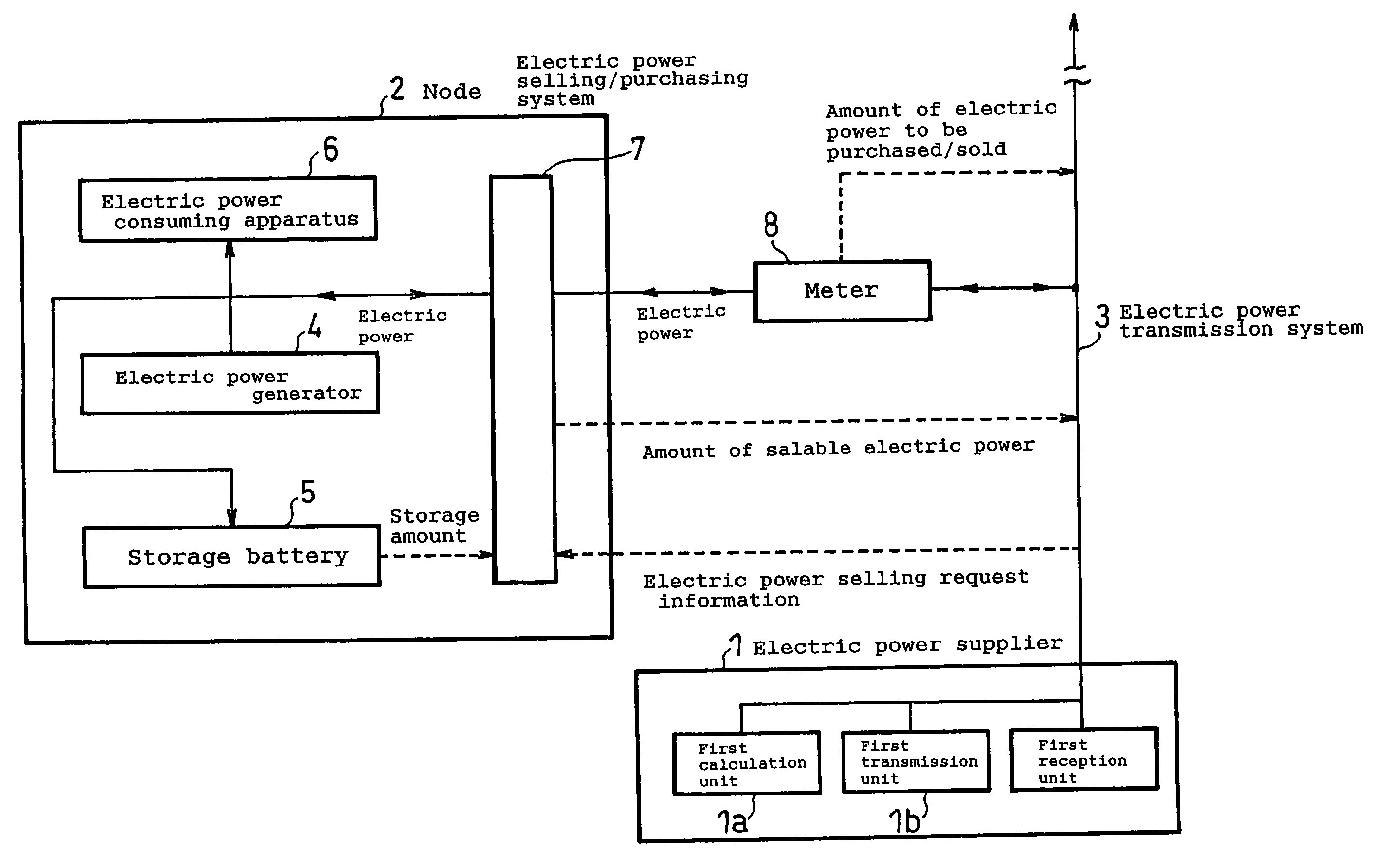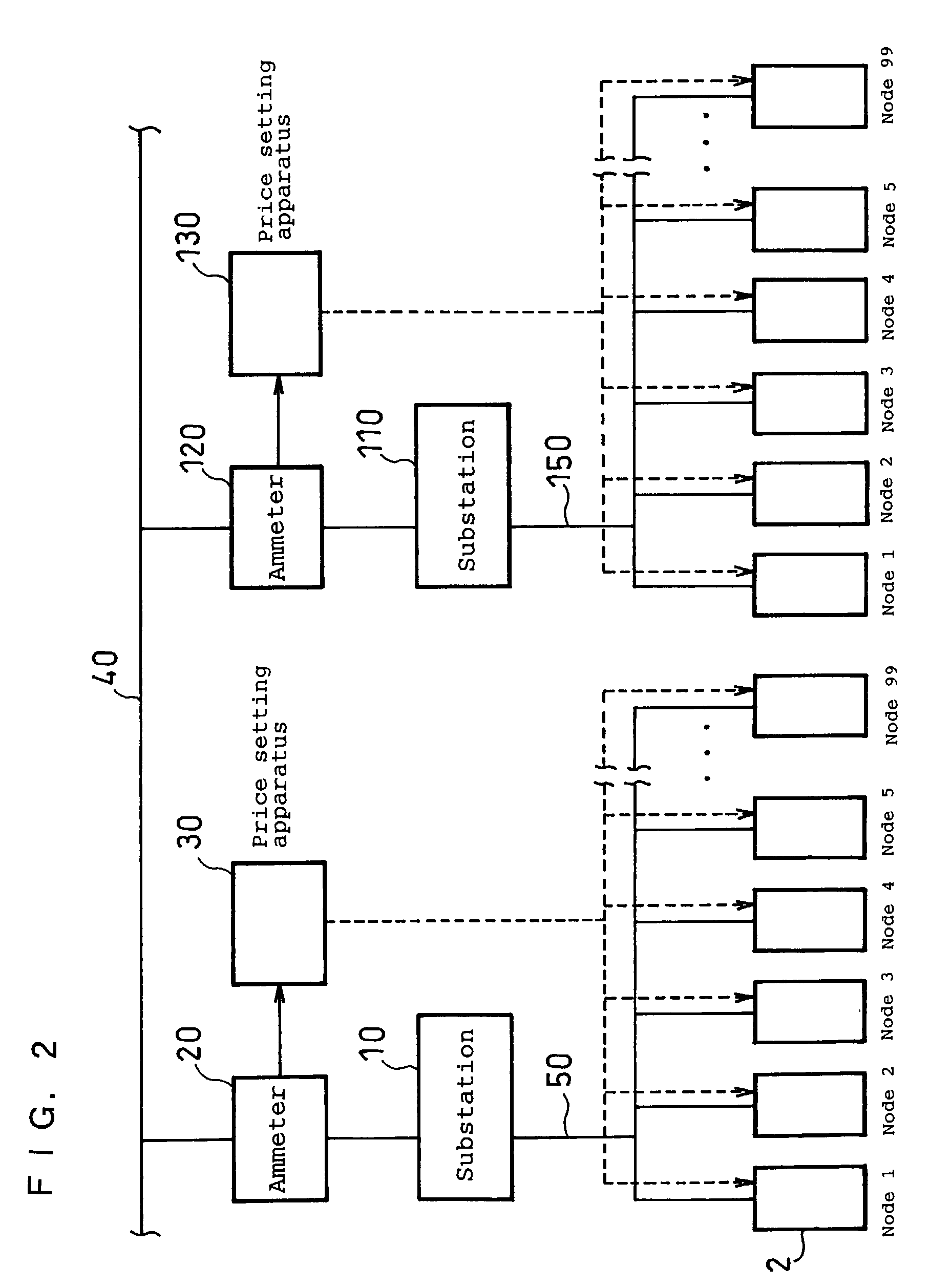Power supply/demand control system
a power supply/demand control and control system technology, applied in process and machine control, electric devices, instruments, etc., can solve the problems of low final energy efficiency, large loss of electric power transmission from electric power stations to consumers, and large loss of electric power transmission
- Summary
- Abstract
- Description
- Claims
- Application Information
AI Technical Summary
Benefits of technology
Problems solved by technology
Method used
Image
Examples
embodiment 1
[0059]Next, preferable embodiment in accordance with the present invention will be described referring to the drawings.
[0060]FIG. 1 is a view showing the configuration of an electric power supply and demand management system in accordance with Embodiment 1 of the present invention. The electric power supply and demand management system shown in FIG. 1 comprises an electric power supplier 1, n (n≧2) nodes 2 and an electric power transmission system 3, and the node 2 has an electric power generator 4, such as a fuel cell, a storage battery 5, and electric power consuming apparatuses 6, such as a refrigerator, a washing machine, an air conditioner and a television set, whereby temporary excessive or lacking electric power can be adjusted by the storage battery 5.
[0061]The electric power supplier 1 has a first calculation unit 1a for obtaining the difference between the total of electric power supplied from the electric power supplier 1 to the node 2 (or a group of a plurality of nodes ...
embodiment 2
[0074]FIG. 2 is a view showing the configuration of an electric power supply and demand management system in accordance with Embodiment 2 of the present invention. In FIG. 2, electric power transmission lines 40 are high-voltage electric power transmission lines and have a high voltage in order to efficiently transmit electricity from an electric power supplier, such as a thermal electric power station, to nodes 2, such as residential areas. Electric power transmission lines 50 and electric power transmission lines 150 are transmission lines for transmitting a voltage to be supplied to each node; for example, the voltage is controlled so as to be maintained at a constant voltage in the range of about 100 to 220 V.
[0075]A substation 10 belonging to the electric power supplier is provided between the electric power transmission lines 40 and the electric power transmission lines 50 and transforms the voltage across the electric power transmission lines 40 to the voltage across the elec...
embodiment 3
[0086]FIG. 3 is a view showing the configuration of an electric power supply and demand management system in accordance with Example 3 of the present invention. Example 3 shown in FIG. 3 is the same as Example 1 in that each node has electric power consuming apparatuses, an electric power generator and a storage battery, but different in that the electric power selling / purchasing system7 used as a second calculation unit determines the selling price of electric power.
[0087]The electric power selling / purchasing system 7 sets the selling price of electric power on the basis of information, such as the current electric power supply capacity and the electric power storage amount stored in the storage battery. For example, the selling price of electric power may be set by subtracting a constant value from a limit cost per unit of electric power of the present electric power generator, or the selling price of electric power may be set lower on the basis of the electric power storage amoun...
PUM
 Login to View More
Login to View More Abstract
Description
Claims
Application Information
 Login to View More
Login to View More - R&D
- Intellectual Property
- Life Sciences
- Materials
- Tech Scout
- Unparalleled Data Quality
- Higher Quality Content
- 60% Fewer Hallucinations
Browse by: Latest US Patents, China's latest patents, Technical Efficacy Thesaurus, Application Domain, Technology Topic, Popular Technical Reports.
© 2025 PatSnap. All rights reserved.Legal|Privacy policy|Modern Slavery Act Transparency Statement|Sitemap|About US| Contact US: help@patsnap.com



